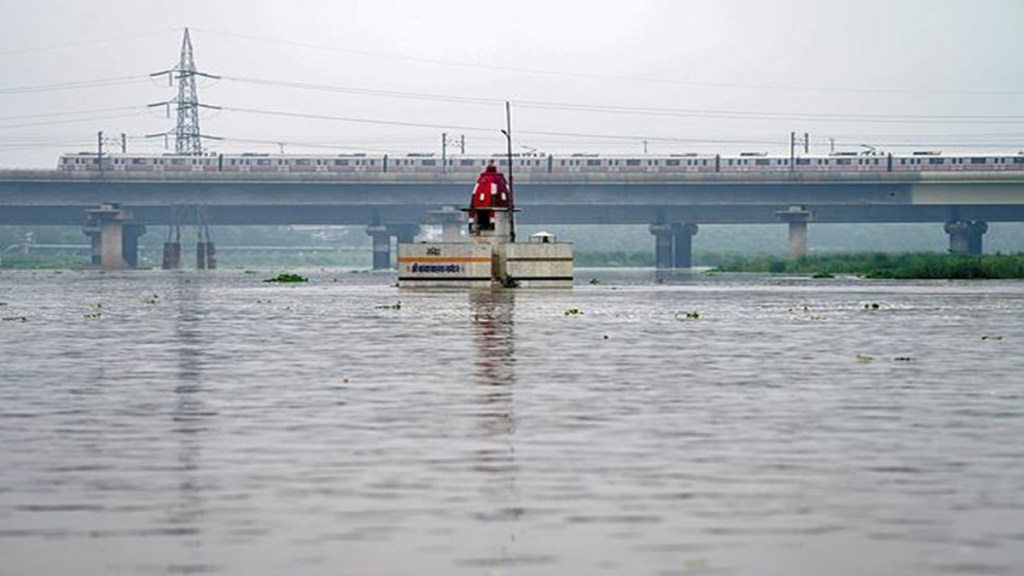The Yamuna River in Delhi is on the verge of crossing the danger mark due to a substantial amount of water being discharged into its upper reaches, Atishi, the Public Works Department minister of Delhi, announced on Monday, expressing concerns about the rapid influx of water into the Yamuna caused by heavy rainfall in north Indian states.
Atishi stated that until Sunday morning, approximately 43,000 cusecs of water was being discharged into the Yamuna from Haryana. However, this quantity has now increased to nearly three lakh cusecs. As a result, she predicted that the water level in the Yamuna would reach the danger mark by around 10-11 am on Tuesday.
Also Read: 2 dead as incessant rain cripples Delhi, schools shut, flood alert issued
In response to the relentless downpour and the potential challenges it poses to the city, Delhi Chief Minister Arvind Kejriwal called for a meeting at the Secretariat. The meeting, attended by Saurabh Bharadwaj, Atishi, and other officials, aimed to address the situation and devise appropriate strategies.
Delhi flood alert: Arvind Kejriwal takes stock – 10 Points
- CM Kejriwal said that while Delhi typically experiences rainfall of 100-125mm, this time the city received 153mm on July 8 and 9. Kejriwal emphasised that Delhi’s infrastructure was not designed to handle such unprecedented rainfall, resulting in difficulties for the residents.
- Considering the potential risks, Kejriwal stated that approximately 41,000 people would need to be evacuated if the Yamuna River crosses the danger mark, reaching a water level of 206 meters.
- Addressing the media, Kejriwal assured the public that all necessary teams were prepared for the evacuation process, and relief camps had been set up accordingly.
- To address the situation, the Public Works Department (PWD) currently has 680 pumps working to clear the standing water. Additionally, 326 temporary pumps have been installed, and 100 mobile pumps are available for deployment. Moreover, preventive measures are being taken to fill potholes temporarily and prevent accidents.
- Kejriwal emphasised that the government was closely monitoring the situation and would issue orders for regional or city-wide school closures if necessary.
- Kejriwal said that the possibility of a flood-like situation in Delhi was primarily dependent on the water released by Haryana into the Yamuna River from Hathnikund, rather than the rainfall in Delhi. He cited historical data, noting that in 1978, there was a flood in Delhi when 7 lakh cusecs of water were released into Hathnikund. However, since then, dams have been constructed on the Yamuna River, and measures have been taken to manage such situations.
- The Yamuna crossed the warning mark of 204.5 metres in Delhi as Haryana released more water into the river from the Hathnikund barrage amid persistent rains in the upper catchment areas. According to a flood bulletin, the water level at the Old Railway Bridge increased 204.63 metres at 1 pm on Monday. The water level is anticipated to rise to 205.5 metres between 10 am and 12 noon on Tuesday, crossing the danger mark of 205.33 metres.
- Kejriwal stressed upon the importance of collaboration between the governments of all affected states to provide relief to the public, urging them not to indulge in finger-pointing during this critical time.
- Delhi witnessed its highest rainfall (153 mm) in a single day in July since 1982 in the 24-hour period ending at 8:30 am on Sunday. The city received an additional 107 mm rainfall in the subsequent 24 hours, exacerbating the situation. The heavy rain transformed roads into gushing streams, parks into watery labyrinths and marketplaces into submerged realms.

